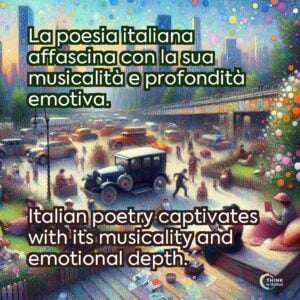Why Italian Poetry Matters
Italian poetry has left an indelible mark on world literature, blending elegance, musicality, and profound themes that explore the human condition.
As a linguist as well as a lover of poetry, I am surely amazed by how Italian poets capture the essence of life, weaving those universal themes into innovative styles to shape global literature and fire the imagination of countless writers and artists.
Italian poetry is deeply connected with the history of the Italian language itself, which emerged from Latin and was refined into its modern form through the works of poets such as Dante, Petrarch, and Boccaccio.
From Dante’s divine vision in The Divine Comedy to Leopardi’s introspective musings on the essence of existence, each poet offers a different lens with which to explore life in its beauty, struggles, and complexities.
Whether drawn by the grandeur of epic tales or by the intimacy of love sonnets, Italian poetry opens onto a timeless journey of discovery, placing the reader at the very heart of Italian culture and history.
This tradition, from its medieval roots to contemporary times, remains a source of wonder for its audiences worldwide with its knack for defying the passage of time while speaking to the human spirit directly.
Let these master poets take you on a world of wisdom and emotion in unparalleled artistry.
The Best Italian Poets of all Time
Dante Alighieri (1265–1321)
Sometimes referred to as the father of the Italian language, Dante Alighieri is generally regarded as one of the greatest poets in world literature.
His magnum opus, The Divine Comedy, is an epic journey through Hell, Purgatory, and Heaven, an immortal creation that deeply deals with morality, spirituality, and human existence, written in Tuscan dialect.
The close theological arguments, with their bright allegorical imagery, are proof of his profound insight into the human soul and the ways of God.
His famous opening line, Nel mezzo del cammin di nostra vita mi ritrovai per una selva oscura (Midway upon the journey of our life, I found myself within a forest dark), remains an abiding icon of self-discovery and existential reflection.
Francesco Petrarca (1304–1374)
Considered the father of the sonnet, Petrarca revolutionized European poetry with his lyrical and introspective style, showing longing, devotion, and the passing of time.
His Canzoniere consists of 366 poems, which are the realization of his unfulfilled love toward Laura, who became the woman that fueled his life’s work.
Beyond his works of poetry, he had become one of the prime movers of the Renaissance humanist movement by mixing the classical ideal with personal expressiveness.
Torquato Tasso (1544–1595)
He is celebrated for his masterful blending of history, romance, and mythology. His epic poem Jerusalem Delivered narrates the First Crusade and interlaces themes of heroism, divine intervention, and forbidden love.
Tasso’s skill in crafting compelling characters, like the star-crossed lovers Tancredi and Clorinda, adds emotional depth and drama to his narrative.
Written in the Baroque style, the poem is marked by its ornate language and vivid imagery, reflecting the grandness and tension of its time.
Giacomo Leopardi (1798–1837)
Leopardi holds a towering position among Italian Romantic greats, with his deeply philosophic and frequently sad poetry. His collection Canti delves into existential questions, the fleeting nature of happiness, and humanity’s relationship with nature.
Born into a strict and intellectually charged household, Leopardi’s frail health and introspective disposition shaped his poetic vision.
His works, like the iconic L’infinito, express a longing for transcendence and the tension between human aspirations and the limits of existence.
The line E il naufragar m’è dolce in questo mare (And shipwreck is sweet to me in this sea) is the most beautiful encapsulation of his profound reflections on life’s paradoxes.
Eugenio Montale (1896–1981)
As a Nobel laureate, he stands as one of the most important modernist poets of the 20th century. His poetry, marked by spare language and striking imagery, explores themes of alienation, nature, and resilience.
Works by Montale echo with the disillusion of a world torn by war and change. In Ossi di Seppia, Montale sets the violence of the Ligurian coast against the inner torment of his characters, using nature as a metaphor for man’s resilience.
His innovative approach redefined Italian poetry for the modern era.
The Highlights of Italian Poetry
Italian poetry has a history that is both enriching and illustrious, developing through distinct eras, each leaving an indelible mark on the literary world.
It starts with the Sicilian School of the 13th century, where Giacomo da Lentini pioneered the sonnet form and developed the themes of courtly love. This period set a foundation for Italian poetic traditions, underlining musicality and emotional expressiveness.
In the 14th century, the Dolce Stil Novo movement came into being, which expressed inner life and spiritual love. I remember when I was in high school, this was my favorite part when studying Italian literature!
Dante Alighieri took this movement to unparalleled heights with The Divine Comedy and is considered one of the greatest figures in literature that the world has ever known.
The Renaissance of the 16th century espoused classical antiquity and humanism. Francesco Petrarca introduced a personal emotion and introspection into the sonnet, glorifying unrequited love and the beauty of individual experience.
The Romantic movement was also well-represented in the 19th century by Giacomo Leopardi, who captured the fragility of human existence and its longing for transcendence.
The 20th century brought modernism with poets like Eugenio Montale, who redefined Italian literature. In this period, poets were exploring alienation, resilience, and the interplay between nature and human struggle.
During these periods, Italian poetry has never stopped mixing novelty with the same evergreen themes. Each era of Italian poetry offers a unique lens into the cultural, philosophical, and emotional depths of the human experience.






